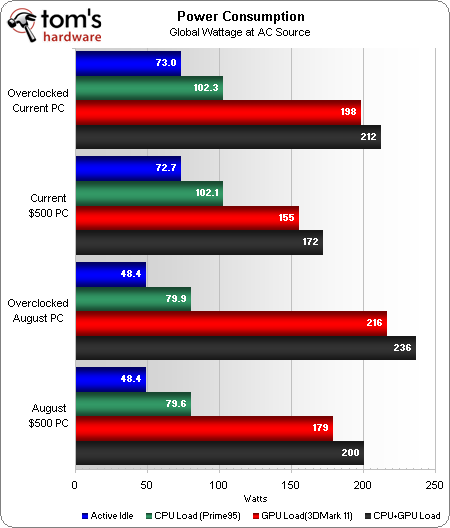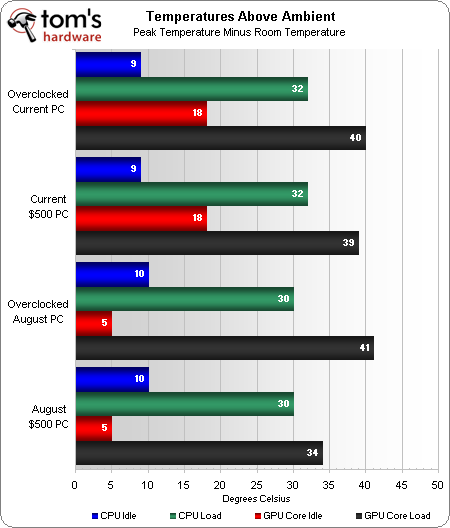System Builder Marathon, Q4 2012: $500 Gaming PC
Power Consumption And Temperatures
In an effort to replicate the way you'd use this PC, we leave power-saving features enabled on both rigs. Also, we don't override the automatic fan controls on either of the stock configurations. As a result, we basically sacrifice thermal performance and impose higher system temperatures in order to enjoy less fan noise.
Both machines employ an Antec VP-450 power supply, which offers respectable efficiency, even if it doesn't boast an 80 PLUS certification.
There's clearly a problem with this quarter's active idle power use on the desktop, since we'd expect it to land right around 50 W. We're thinking that something was messing with the graphics card's power management. And, despite our best efforts, we were unable to solve this mystery.
Monitoring utilities confirmed for us that, at its stock and overclocked settings, the card was properly idling down to its 2D frequencies and voltage levels. Our power meter begs to differ, though. Confirming our suspicion of PowerColor's card is the fact that, when the system enters standby, consumption drops under 42 W instead of giving us the 10-12 W reduction expected from ZeroCore kicking in. For one reason or another, our graphics card simply chews up an extra 20 W on the Windows desktop.
Though the performance of Intel's bundled heat sinks and fans isn't particularly impressive, they serve up quiet operation and adequate cooling, particularly since we're unable to overclock.
At a 20-25% fan duty cycle, our Radeon HD 7850 runs hotter than last quarter's GeForce GTX 560. It's entirely possible that the higher temps are directly attributable to the power consumption issues mentioned above. But GPU load temperatures weren't a big problem. Both overvolted and overclocked cards had cooling in reserve. The Radeon barely hit a 50% duty cycle, while the GeForce peaked at 53%.
Current page: Power Consumption And Temperatures
Prev Page Benchmark Results: Productivity Next Page Is This Our Best $500 Gamer Ever?Get Tom's Hardware's best news and in-depth reviews, straight to your inbox.
-
Crashman killerchickens$501 Plus $100 for a copy of windows 7.Run Linux, this is a hardware shootout.Reply
-
killerchickens CrashmanRun Linux, this is a hardware shootout.Reply
Linux for a gaming desktop I dont think so.
-
jerm1027 ReplyOur best alternative remained the quad-core Phenom II X4 995 Black Edition for $95. But we chose not to revisit this old favorite, figuring that adding a Radeon HD 7850 would have taxed our budget.
What about the Phenom II 965? It's only $75 at TigerDirect. -
EzioAs Reply9539399 said:I personally feel that they could have gone with H61 and gotten a 2GB 7850 instead.
I think they'd be better off with a B75 motherboard, 4GB RAM and an i3-3220. -
mayankleoboy1 I am not very comfortable using windows8 in these benches. Reason : Drivers have not yet matured for win8. I would have waited for the next quarter SBM before using win8.Reply -
killerchickens Windows is free and we use Linux in are gaming Machines what are we in Soviet Russia .Reply


